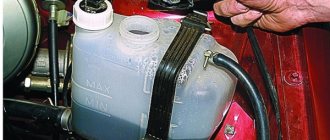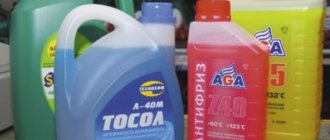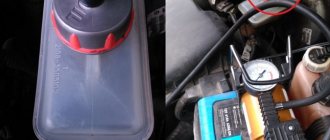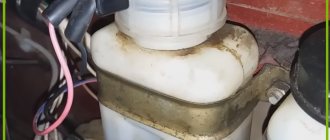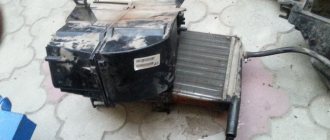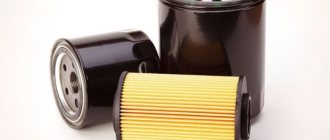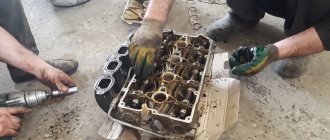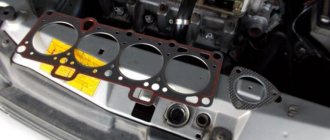Welcome! Coolant - without it, cars would boil, because it plays the most basic role in the engine cooling system, namely, it flows through the pipes and cools them, and this liquid itself is cooled by the radiator and the fan that blows on it, as well as the radiator blows the air flow, this becomes especially noticeable when driving a car quickly, when the car practically does not heat up.
Note! In order to replace the coolant, you will need to stock up on: Firstly, an empty, preferably very wide container (It will be most convenient to use an ordinary basin, which is unnecessary for anyone, or if you are replacing it in a pit, then it will be possible also use a bucket, or something else where you will drain all the waste liquid), and you will also need to take with you a wrench somewhere “13” and “17” and find, as already mentioned, an inspection hole , because replacing the coolant in the inspection hole will be much more convenient than trying to drain it while the car is standing on the ground, although in this case it will be possible to jack it up, but keep in mind the fact that you will need to place bricks under the rear wheels, otherwise the car may simply fall off and fall to the ground, and by the way, if you lift the front of the car with jacks or with just one jack and put bars or boards under the other side (don’t ever put bricks under the car, there have been cases when they fell apart and the car fell to the floor), so make sure that the front part of your car is at the same level and make sure that the right part, for example, is not higher than the left, and the left is not higher than the right!
When should you change the coolant? In fact, it all depends on what kind of liquid you purchased in the store, respectively, if it is fake, then in this case you will have to replace it immediately, otherwise corrosion will begin to occur in parts of the car engine (More on this below in the “Note!” paragraph), but what should I do if I bought a car and the owner told me that he changed all the lubricants (Oil, antifreeze, etc.) in my purchased car, how can I check this, you ask?
It’s all very simple, in order to check whether it’s time to change the fluid or not, first open the expansion tank, which is closed with a lid (Open the tank only on a cold engine, otherwise if your system is depressurized, then the fluid may simply splash out sharply when the engine is heated and go jet, this will cause you burns), so after unscrewing the cap (Indicated by the arrow in the photo below), take a visual look at the color of the liquid you have in the tank, basically all liquids that cool the system have a certain color, that is, antifreeze can be blue , antifreeze red, etc.
Therefore, after you have looked into the tank, visually determine whether the fluid needs to be replaced or not, namely, it will need it if it changes its color to the color of rust, and also if an oil film appears on the surface (This can be very easily determined visually). .
Note! Many people put off replacing this fluid, but the car is running hot, so what do they say, remember once and for all, most engine parts, for example, parts such as the crankshaft, camshaft, the cylinder block itself, etc. They are lubricated with coolant due to the fact that small holes are made in these parts so that this liquid gets into them and cools them from inside, and in the case when the coolant becomes unusable, it begins to gradually, so to speak, devour all these parts due to why premature corrosion occurs, which can ultimately lead you to a major engine overhaul, but it seemed like it was just some kind of coolant, and so many troubles can be caused by it, so when purchasing, be careful too, as at the moment, a lot of fakes are sold on the market! (For information on how to identify counterfeit coolant, see the interesting article entitled: “Detailed information about antifreeze and the so-called antifreeze that is poured into a car engine.”)
How to replace coolant on a VAZ 2110-VAZ 2112?
Note! Before we begin, we will give you a couple of tips so that you are prepared to face this situation, namely, many car owners constantly grab their heads when they pour liquid into the tank, after which some time passes, they open the hood and see that the liquid has dropped below the level (Now you will understand where this is all leading, read carefully), we even once observed such a situation, a young man of about 20 years old came to us, he wanted us to change his expansion tank for a new one and he told us that I had recently poured new fluid into the reservoir, after which he drove the car and it fell a little, we asked him, and when you checked the fluid, the engine of your car was cooled down (That is, the check was carried out on a cold engine), he answered us that no, the engine was hot, but when he looked at the marks that are located on the sides of the barrel, he saw that a small part of the liquid had disappeared, we explain why this happened!
The thing is that the cooling system pipes constantly change their shape, they either expand (If the engine is very hot) or narrow (If the engine is cold), so as a rule, the coolant level should only be checked on a cold engine, because on a hot one it really is the fluid may even be less than the minimum MIN mark, but this does not mean that you need to immediately run and pour new fluid into the tank, in this case you just need to wait until the engine cools down, thereby you will even see how the fluid becomes a little more in expansion tank and only after that you will need to add new fluid into it and continue driving! Draining: 1) At the very beginning of the operation, find a place where your car will stand level, or if this is not possible, then place the car so that the front of the car is higher than the rear, but not vice versa.
2) Then remove the “-” terminal from the battery, otherwise if liquid gets on the exposed wires, a short circuit may occur, which in turn will cause a malfunction of the wires on which the liquid gets. (For information on how to remove this terminal, see the article: “Replacing the battery on all VAZs,” point 1)
3) Next (This operation is only for injection machines), remove the ignition module so that it does not interfere with unscrewing the drain plug of the cylinder block. (For information on how to remove the module, see the article: “Replacing the ignition module”)
Note! The module needs to be removed only with the bracket, because if you remove only one module, then in this case the bracket of this module will block the way to the drain plug, so we remove everything together!
4) Next, to drain the coolant from the system a little faster, unscrew the cap that covers the cooling expansion tank.
5) Then, using a wrench or, best of all, a spanner, completely unscrew the plug that is located on the engine cylinder block, you got to it earlier when you removed the ignition model from the car to access it, so for a more detailed location of this plug, look at photo below, where a man points his finger at this traffic jam:
Note! Before you start unscrewing this plug, be sure to place an empty “10 liter” container under this plug, and after this plug is unscrewed, drain all the coolant from the cylinder block into this container!
6) Then, when all the liquid from the block has been drained, we recommend that you wipe the car engine with any rag, namely, wipe the places where the liquid got in when draining.
7) Now do not wrap this plug and go to the plug that is located on the radiator and in the same way unscrew it completely, and drain all the liquid remaining in the radiator into a container.
Note! Next to the radiator drain hole there are wires and the generator itself. If possible, try to protect these things somehow, for example, throw a rubber rag over them so that liquid does not get on them, otherwise they can easily fail!
 Next, screw all the unscrewed plugs back into place, because all the liquid from the system has been drained, so now we will move on to filling.
Next, screw all the unscrewed plugs back into place, because all the liquid from the system has been drained, so now we will move on to filling.
Filling: 1) First (This point applies only to the injector, but be sure to read the note if you have a carburetor), loosen the clamp and remove the fluid drainage hose from the throttle assembly, it is also called the throttle valve, and then put this in some convenient place hose (So that it does not fall) and pull the part with which it was connected to the throttle up to the very top and leave it like that.
Note! If we are talking about a carburetor engine, then in this case perform exactly the same operation but only with a slightly different hose, namely with the carburetor heating hose, it is indicated by the arrow below:
2) Then carefully start pouring coolant to the required level and watch whether this liquid flows from any hose, if it flows, immediately stop pouring the liquid (Put the canister on the floor) and put the hose in its place, and after putting it on, fill it liquid to the required level and tighten the plug.
Note! If you keep pouring liquid and pouring it, but it doesn’t come out of the hose, then stop pouring and grab this hose with your hand and then carefully lower it slightly, if the liquid poured as indicated by the arrow in the photo below, then in this case, put this hose in its place, tighten the clamp that secures it and continue to pour liquid into the tank to the required level!
3) And finally, if after replacement (no matter how long) you notice that your engine is heating up very much, and the stove is not heating at all (cold air is coming out), then in this case, remove the air lock from the system. (How to remove a plug on an injector, see the article: “Removing an air plug on a VAZ”)
Note! On the carburetor, the plug is removed in the same way as on the injector, so read the article to which there is a link if you have a carburetor, but just always remember that on the carburetor there is another hose, that is, a heating hose, and on the injector there is another hose that is connected to throttle fitting, in general, read it carefully and you will understand what we are talking about!
Important! 1. Be sure to change this fluid only on a cold engine, otherwise when the engine is hot, it sometimes heats up to very high temperatures of the order of 95-110 degrees and maybe even higher (The coolant temperature is shown on the instrument panel on a special sensor, some people still called the engine temperature sensor), so it cannot be replaced on a hot engine, because you can very easily get scalded by it when draining.
2. Also, be sure to take into account the fact that coolant is a very toxic substance, so if it gets on your skin or eyes, run immediately to the washbasin and rinse the area, otherwise this liquid will harm your body.
Note! By the way, do not take and under no circumstances leave an open bottle of this liquid at home, because the vapors of this liquid are also poisonous and can also harm your body!
3. And in conclusion, let’s note some factors, namely, replace this fluid only with gloves (You can do without them, but there is a possibility of drops of this fluid getting on the skin), and also do not under any circumstances drain the used fluid onto the ground, that’s all take care of the environment and, first of all, take care of the ecology of our country and something else, if you decide to add this liquid to the tank, for example, it runs out there, first of all, do not mix it with anything (Meaning exactly what is needed fill in liquid of the same brand and produced only from one manufacturer and this is mandatory) and secondly, after topping up, do not under any circumstances start the car with the expansion tank cap open, since it must be closed when starting!
General cooling system maintenance tips
First of all, you need to adhere to the following safety tips:
- Cool the car completely; its engine should be completely cold.
- Remember that antifreeze is a fairly toxic liquid, so you should not allow it to get into the stomach, skin or eyes. Wear gloves when working.
- After you fill in new antifreeze, you can start the car only after installing the expansion tank cap in place.
If you have replaced the heater core, you need to check the operation of the fan. To do this, monitor the coolant temperature on the dashboard. If the arrow reaches the red zone and the fan still does not turn on, you need to turn on the airflow from the heater. Cold air indicates an air lock, and hot air indicates a fan malfunction.
You can remove the plug from the air when the power unit is turned off and cooled; to do this, you just need to unscrew the cap of the expansion tank.
Replacing antifreeze on a VAZ 2112
Photo VAZ 2112
If you buy a car, put it in a cupboard and admire it, then you definitely won’t need to replace any working fluids. And since a normal car is constantly in use, it requires maintenance. One of the types of work that needs to be done is replacing antifreeze or antifreeze - in a word, coolant.
Cooling system design
This article provides instructions on how to replace antifreeze in a VAZ 2112 yourself. Here you will find some features that are important to pay attention to when replacing the coolant, a video on the replacement and a detailed description of the process itself.
REPLACEMENT WITH WASHING
Is it possible to replace antifreeze with antifreeze? Why not. It is only necessary to flush the cooling system when replacing antifreeze with antifreeze. Conversely, you need to flush the cooling system when replacing antifreeze with antifreeze. We have already indicated the reason for flushing - the compositions are different and mixing can lead to foaming of the coolant. Of course, an explosion will not occur, but long-term use of the mixed composition is not recommended. The system should be flushed with clean water, and the water should be changed several times. Rinse until clear liquid, free of dirty impurities, drains from the radiator.
Replacing the coolant on a VAZ is done with your own hands in stages:
- We park the car level; at an angle, all the coolant may not drain out;
- Remove the expansion tank plug;
- Unscrew the drain plug at the bottom of the radiator. We prepare the container into which the contents from the radiator are drained in advance;
- We twist the plug on the cylinder block and drain the coolant from the block. To get to the plug, you need to remove the ignition module. The module is secured with three bolts;
- We tighten the plugs, fill in water and start the engine. Let the engine run for fifteen minutes;
- As already written above, we flush the system several times;
- Then fill in new fluid and remove the airlock. How many liters of antifreeze are provided in the VAZ 2114, so many should enter the system.
WHY CHANGE ANTIFLEGE AND HOW OFTEN DO IT?
Let's start by answering the first question - do you need to change antifreeze and why change it? The answer is clear - it needs to be changed, since it, like everything else, has the excellent ability to lose its properties.
VAZ 2112 how to replace antifreeze
Plus, the loss of the quality of the liquid occurs not only from the expiration date, but also from the fact that it is in an engine that is subject to corrosion - that is, the antifreeze becomes brown or red.
How often is it necessary to replace antifreeze on a VAZ 2112? According to official data, this must be done every 2 years or every 45 thousand km. Some advise changing every year.
This is often not necessary. If the car is old and “leaks” every winter, then this can be done. But the VAZ 2112 is not a rare car, so once every two years will be enough. How else can you determine that antifreeze needs to be changed? This can be done by color.
Looking into the expansion tank, see what color the antifreeze has become. Pure antifreeze has a bright blue color. Black and red color is a clear indicator of the need for replacement.
Antifreeze should have the color as in the photo
Reasons for replacement
When replacing antifreeze on a VAZ 2110, you must adhere to several rules. The engine must be cold, antifreeze is a toxic liquid; when working with it, it is necessary to avoid contact with the eyes, mouth and prolonged contact with the skin.
Antifreeze, coolant (antifreeze) is a special composition of automotive fluid based on ethylene glycol. Used in the cooling system of an internal combustion engine (ICE) for operation at low ambient temperatures. There may be several reasons for replacing antifreeze:
- car mileage, 75,000 - 100,000 km. mileage;
- time interval 3 - 5 years (it is recommended to check the condition of the fluid at a car service every year before the start of the winter season with a special device);
- replacing one of the components of the cooling system, water pump, pipes, radiator, heater, etc., with such replacements, antifreeze is still drained from the cooling system and it makes sense to fill in a new one.
ANTIFREEZE OR ANTIFREEZE?
The answer to this question is not clear-cut. If you do not take into account the car manufacturer, but look solely at the quality of the coolant, then antifreeze, of course, loses to antifreeze.
There are different types of antifreeze
Antifreeze has many additives that can make it very suitable for winter. Freezing and boiling temperatures can make a huge difference. Another point is that antifreeze is specially designed for VAZ cars. It is suitable for our climate and operating conditions. Another plus is that the price of antifreeze is much lower than that of antifreeze. Usually, owners of VAZ cars pour antifreeze and drive with a clear conscience.
ESSENTIAL TOOL
What tool is needed to replace antifreeze in your VAZ 2112:
- Head 13 with ratchet or wrench
- Head or wrench 17
- Key for 10
- Container for draining antifreeze
- Watering can
Any basin that will fit under the car will do.
That's probably all you need. As you can see, no special costs are required.
REPLACEMENT OF ANTISEASE
Now let's move on directly to replacing the antifreeze with our own hands.
Advice! Before replacing antifreeze, remove the protection from the engine. Firstly, the liquid will drain more easily. Secondly, it will be easier for you to “catch” the stream with a basin.
Removing protection for VAZ 2112
Before draining the antifreeze, unscrew the negative terminal of the battery. This is done to prevent the wires from shorting, because liquid will get on them.
Draining antifreeze
Drain the coolant. The fluid is drained only from a cold engine. So:
- First you will need to use a 13 and 17 key to unscrew the ignition module with the bracket. You can, of course, try and unscrew the drain plug from the block without removing the bracket, but more effort and nerves will be spent.
Replacing antifreeze VAZ 2112
- Now we unscrew the drain plug of the VAZ 2112 cylinder block. This is done using a 13mm socket and a ratchet or other convenient wrench.
- After this, very little liquid will drain. Now unscrew the expansion tank cap to drain all the fluid from the block. You can do this in advance.
- Next, you need to unscrew the drain plug from the cooling radiator. You don't need any tools for this - it can be easily unscrewed by hand.
Radiator drain plug
- After all the liquid has drained from the block and radiator, you need to screw back the two plugs.
- Reinstall the ignition module with bracket.
This is where the drain ended.
Flushing the cooling system
Often, replacing antifreeze on a VAZ 2112 can be done without flushing the system. You don’t have to do it, in principle, but consider the option of washing.
Note. To flush the engine cooling system, you can use a special flushing liquid, or you can use ordinary distilled water.
Flushing the cooling system
So:
- To flush the engine, pour the required amount of distilled water or a specially prepared flushing solution with water into the engine.
- After this, start the engine and give it time to run. About 10 minutes.
- Then drain the water and repeat the procedure.
- You can rinse until the water becomes clear when drained. But considering that often washing is not done at all, two times will be enough.
Pouring antifreeze
After draining the antifreeze and flushing the cooling system, it is necessary to fill in new antifreeze. It will require about 8 liters.
It’s more convenient to pour antifreeze with a watering can
So:
- We insert a watering can into the hole in the expansion tank for convenience.
- We fill the antifreeze gradually so that the air leaves the system.
- To completely fill the system, squeeze the upper pipe coming out of the radiator.
- After filling the system, pour about half into the expansion tank.
Advice! Under no circumstances fill the expansion tank full! Antifreeze will simply pour out of there!
Eliminating airiness
If you do not perform some operations, the cooling system of your VAZ 2112 will be air-filled and will not work correctly. To eliminate this defect, do the following:
- Again, during pouring, squeeze the pipe so that air comes out.
- After filling, it is necessary to create pressure in the expansion tank. In simple terms, just blow into the expansion tank. Not just of course, but pressed against it so that air does not escape through the filler neck.
- In this primitive way, pressure can be created and air will leave the system.
- A sign that there is no air left in the system is the release of antifreeze, not air, from the return line.
- Also, after starting the engine, you need to “give” the engine good speed - this also helps.
These are some simple ways to get air out of the cooling system.
Stages of work with replacing coolant in a VAZ 2110
Before starting the main stages of work, it is necessary to prepare the work surface, tools and equipment.
During such work, the vehicle is placed on flat surfaces or at a height. The engine must be completely cool.
The replacement process will require small containers, 8, 13 and 17 wrenches, water and new antifreeze.
Replacing antifreeze with antifreeze in a VAZ consists of the following steps:
- coolant drain;
- flushing the system;
- filling in new refrigerant.
In VAZ 2109, 2111, 2114 models, flushing the cooling system is not necessary. It is only required if the drained antifreeze was contaminated with rust or scale.
In models VAZ 2111, 2109, 2106, 2110, before replacing, it is necessary to disconnect the negative terminals of the battery so that a short circuit does not occur when draining the antifreeze.
In models 2110, 2112, 2115, after draining the fluid, the car should be started and the engine should be left running for 4-5 minutes so that all the fluid is pumped through and out of the system. Without this moment, the remaining antifreeze, which is not removed independently, will mix with the antifreeze and can lead to engine damage.
Draining antifreeze
It is best to drain the liquid at a height: the car should be placed on a lift, overpass or above a repair pit.
Before draining antifreeze on a VAZ 2110 and other models, make sure that the system has completely cooled down.
Draining is quite simple:
- A container for old antifreeze with a volume of 10 liters or more is placed under the car.
- The cover is removed from the expansion tank of the system and the drain plug is unscrewed from the cylinder block with a key set to “13”.
- During the process, the plug can be supported so that it is not blown away by the pressure of the liquid.
When the antifreeze is drained from the VAZ block, the plug is screwed back on. The next step in draining is draining the antifreeze from the system radiator. The process is carried out in the same way as with the cylinder block. You can also tighten the cap on the radiator yourself, without any equipment or tools.
Flushing the system
Flushing, as a step when replacing antifreeze, is necessary if the car is already very old and the cooling system has never been cleaned. On the other hand, the risks increase that if you flush the system during replacement, you can clog the radiator, thermostat and heater radiator.
Washing is carried out as follows:
- old antifreeze is drained;
- all plugs are screwed into place;
- Distilled water is poured into the tank to the maximum level;
- the engine starts and warms up to operating temperature;
- the working engine is left for 5-10 minutes;
- the car turns off and cools down;
- After cooling, the water is drained from the tanks.
If the water remains dirty when draining, the operation must be performed several times until it becomes clean.
Filling with new antifreeze
When adding new coolant, you will need about 9 liters of new coolant. Ideally, antifreeze in a VAZ 2110 should be replaced every five years, but on older models it is better to change the fluid every second year.
Filling in new antifreeze occurs step by step:
- The drain plugs are screwed in;
- The hose on the throttle assembly is unscrewed;
- New fluid is gradually poured in;
- You should stop when the antifreeze reaches the extreme level;
- The hose is twisted;
- The liquid is added to the maximum mark;
- The tank closes and the engine with the stove starts;
- The engine warms up to operating temperature and turns off;
- The replacement has been made.
The procedure is standard, but not suitable for all systems. How to change antifreeze to antifreeze in a VAZ with 16 valves? The procedure is carried out differently. After the liquid is poured into the tank, air is removed through the expansion tank, then the car starts and you need to drive it for several kilometers. The system is checked again and the liquid that has escaped is added.
Why is it worth switching from antifreeze to antifreeze: pros and cons
What is better: antifreeze or antifreeze and why it is worth replacing one with the other - these are questions that many drivers of domestic cars ask.
The advantages of antifreeze in these matters are obvious:
- high boiling points;
- long service life;
- cleans the cooling system;
- produced for long mileage.
Antifreeze is a cooler that was created for the domestic auto industry, and for many years it served our cars. However, antifreeze had to be changed every 2 years, and antifreeze is designed for 5 years of operation.
In fact, antifreeze and antifreeze are the same thing. Only the latter is an improved version of the liquid. It follows from this that replacing the refrigerant in a VAZ is an important procedure that has a positive effect on the operation of the engine and other components.
When you decide to replace antifreeze with antifreeze in your car, follow the instructions, because the slightest mistake can lead to major damage to the car’s systems.
